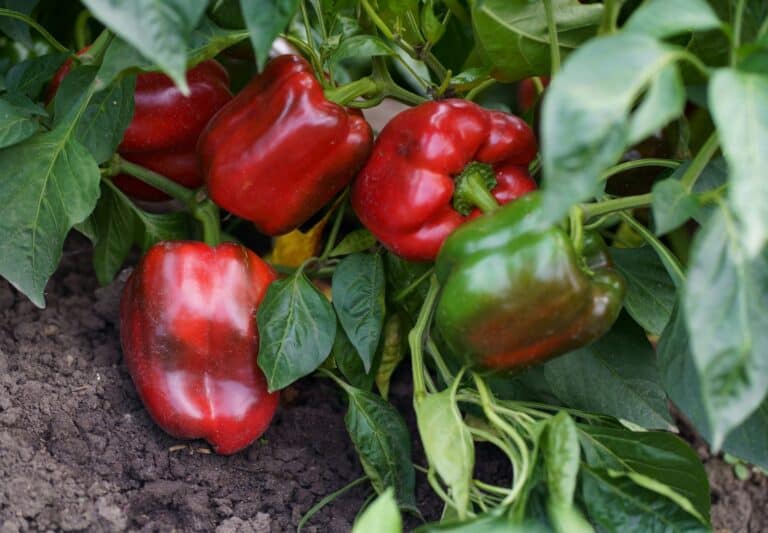How to store peppers (Should peppers be refrigerated?)
Properly storing peppers is essential to preserve their freshness, taste, and nutritional value, whether you’ve harvested an abundant crop from your garden or bought them at the grocery store.
This guide will cover the ideal storage conditions for peppers, the pros and cons of refrigeration, and various preservation techniques to ensure you can enjoy peppers year-round.
Should peppers be refrigerated?
Storing peppers at the right temperature and humidity is key to maintaining their quality. Peppers should ideally be stored at around 45°F (7°C) with a humidity level of 90-95%. Temperatures lower than 45°F can cause chilling injuries, negatively impacting the peppers’ texture and taste. Most household refrigerators operate at 40°F (4°C) or lower, so it’s important to be cautious when storing peppers in the fridge to avoid damaging them.
To store peppers in the refrigerator:
Avoid Cold Spots: Place peppers away from the coldest parts of the fridge to prevent chilling injuries. If your fridge runs colder than 45°F, consider adjusting the settings or storing peppers outside the refrigerator if the ambient temperature is appropriate.
Monitor Temperature Zones: Use a thermometer to check the temperature in different parts of your refrigerator. Peppers should be stored in the warmest area, typically the crisper drawer, where humidity is also higher.
What to store peppers in
Selecting the right container is crucial for maintaining pepper freshness and preventing moisture buildup, which can lead to spoilage. Here are some guidelines:
Loose Storage: If you have a crisper drawer with proper humidity control, you can store peppers loosely in the drawer without any bags. This method works well as long as the humidity is adequate to keep the peppers fresh without excess moisture.
Avoid Plastic Bags: Plastic bags can trap moisture, which may cause peppers to rot. Instead, opt for breathable materials like reusable cloth bags that allow air circulation while regulating moisture levels.
How to store cut peppers
Once peppers are cut, their shelf life decreases significantly, so it’s important to store them properly to maximize freshness:
Consume Quickly: Cut peppers should be consumed within 3-5 days for the best quality and taste. If you can’t use them within this timeframe, freezing is a good option to preserve them for later use.
Use Sealed Containers: Store cut peppers in airtight containers or resealable bags to prevent them from drying out or absorbing odors from other foods in the refrigerator.
Add a Paper Towel: Placing a paper towel inside the container or bag can help absorb excess moisture, preventing the peppers from becoming mushy.
Can you store peppers with other fruits and veggies?
Peppers can be stored with other fruits and vegetables without major concerns. Unlike some produce that is sensitive to ethylene gas, such as bananas or avocados, peppers are not significantly affected by ethylene. This means that peppers can be stored alongside ethylene-producing fruits like apples without accelerating spoilage.
However, to optimize space and organization in your refrigerator, it’s still advisable to keep peppers in a designated drawer or compartment with other vegetables that have similar storage needs. This helps maintain consistent humidity and temperature conditions, which are crucial for prolonging the shelf life of all your produce.
How long do peppers last?
The shelf life of peppers depends on their initial freshness and how they are stored:
Extending Shelf Life: If you want to keep your peppers beyond their fresh state, consider preserving them through methods like freezing, canning, or drying. These techniques can help you enjoy peppers long after the fresh ones would have spoiled.
Freshly Harvested Peppers: When stored at the ideal temperature of around 45°F (7°C) with 90-95% humidity, peppers harvested from your garden can last up to 2-3 weeks. This storage method allows you to enjoy their full flavor and texture for an extended period.
Store-Bought Peppers: Peppers purchased from the store may already be several days old by the time you buy them. Consequently, their shelf life will be shorter than freshly picked peppers. For the best quality, consume store-bought peppers within a few days to a week after purchase.
Should you wash peppers before storing them?
It’s generally recommended not to wash peppers before storing them, as excess moisture can promote mold growth and spoilage. Here’s how to handle them:
Washing Before Use: When you’re ready to use the peppers, rinse them under cool running water just before cutting or cooking. This ensures they are clean and free from surface contaminants without introducing moisture during storage.
Unwashed Storage: Store peppers in their natural state without washing to keep them dry and fresh. If they are visibly dirty, gently wipe them with a dry or slightly damp paper towel to remove any dirt.
How to preserve peppers to store them long-term
If you have more peppers than you can use within a few weeks, several preservation methods can extend their shelf life. Here are some effective ways to keep your peppers fresh and flavorful for longer:
Freezing
Freezing is a simple and effective method to preserve peppers for long-term storage. Here’s how to do it:
- Whole Peppers: Hot peppers can be frozen whole. Wash and dry them thoroughly before placing them in freezer bags.
- Sliced Peppers: For larger sweet peppers, slice or dice them. Freeze them in a single layer on a cookie sheet before transferring them to a freezer bag to prevent sticking.
- Storage Tips: Freeze peppers at 0°F (-18°C) or lower to maintain their quality and flavor.
Canning
Canning allows you to preserve peppers in various forms, such as pickled or in brine. There are two main methods:
- Pickling: Peppers can be pickled and then water bath canned, preserving their flavor with a tangy twist.
- Pressure Canning: For non-pickled peppers, pressure canning is necessary to ensure they are safely preserved.
Drying
Drying peppers is another effective preservation technique that concentrates their flavor. You can choose from several drying methods:
- Air Drying: Hang peppers in a well-ventilated area to dry naturally.
- Sun Drying: Place peppers in direct sunlight to dry, ensuring they are protected from pests.
- Oven Drying: Dry peppers in the oven at a low temperature.
- Dehydrator: Use a food dehydrator for a more controlled drying process. Once dried, store peppers whole or grind them into spice.
Fermenting
Fermentation involves beneficial bacteria breaking down the sugars in peppers, creating a tangy and flavorful product. There are two main ways to ferment peppers:
- Fermented Mashes: Roughly blend the peppers to create a mash and allow it to ferment.
- Fermented Whole Peppers: Peppers can also be fermented whole in a saltwater brine.
Hot Sauce
Making hot sauce is a creative way to preserve peppers while adding flavor to your meals. Here are some tips:
- Recipe Tips: Combine peppers with vinegar, citrus juice, and other ingredients to create a unique sauce. Ensure the sauce has a pH of 4.6 or below for shelf stability.
By utilizing these preservation methods, you can enjoy the taste and benefits of your peppers long after their fresh counterparts would have spoiled.
Proper storage of peppers is key to preserving their freshness, taste, and nutritional value. By understanding the best practices for refrigeration, container selection, and preservation methods, you can extend the life of your peppers and reduce food waste.
References:
Slama, J., & Diffley, A. (2013). Wholesale success: A farmer’s Guide to Food Safety, selling, postharvest handling and packing produce. FamilyFarmed.org.






